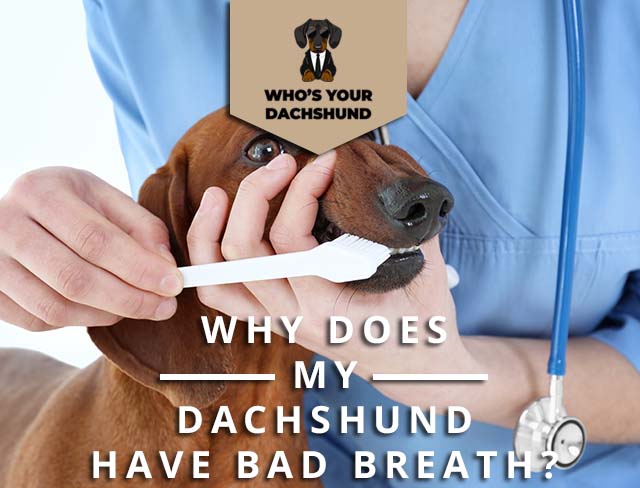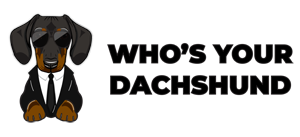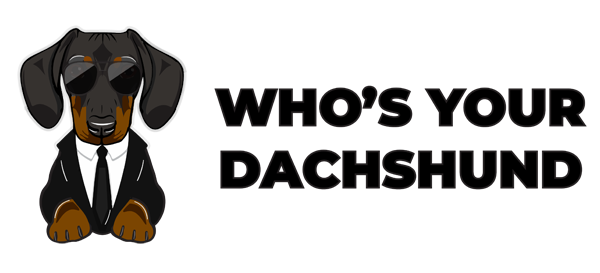
Dogs have bacteria in their mouths, and if they’re not brushed regularly, foul breath will happen. The best way to remove this bacteria is by brushing your dog’s teeth. Alternatively, you can add a toothbrush or treat to your dog’s diet or use a human toothbrush and toothpaste to brush your Dachshund teeth. Otherwise, treating any other possible health conditions can help eliminate your dog’s bad breath.
What You Can Do to Prevent Foul Breath
The first step to preventing bad breath is identifying what type of bad breath you have. There are two types of bad breath: oral and general. Identifying the cause of your bad breath will help prevent it.
General causes of bad breath include:
We know that allergic reactions to foods can be caused by something else, but they can also signify more severe conditions, such as gingivitis or cancer.
Mouth issues:
- Bad teeth.
- Gum disease.
- Bone loss in the jaw.
- Periodontal disease leads to tooth decay and gum disease.
Poor blood circulation in the mouth can contribute to bad breath and hemorrhoids.
Medical conditions: diabetes, polycystic kidney disease (PKD), kidney failure, liver disease, and many others.
Infections: pneumonia, strep throat, and many others.
What You Can Do to Treat Bad Breath
Bad breath is a symptom of numerous medical conditions, dental issues, and lifestyle choices. It can be caused by food particles left on the tongue, bacteria in the mouth, dry mouth syndrome, sinus infections, smoking, and many other factors. Poor dental hygiene is responsible for most dog breath issues, and brushing your dog’s teeth is crucial to preventing it.
- Using a toothbrush or toothpaste designed for dogs is necessary for keeping your dog’s gums healthy and white. If you don’t have one on hand, a child’s toothbrush will work. However, be careful to ensure the toothpaste is safe for dogs as many contain xylitol which can lead to organ failure in dogs if it isn’t adequately diluted (or not at all).
- Using canned pumpkin or cooked sweet potato as a treat is a great way to get your dog to brush their teeth. Don’t give raw pumpkin, sweet potato, or any high sugar foods as treats, and make sure you are feeding small meals to your dog daily. If they won’t eat their food, can you need to consider switching brands?
- Brushing your dog’s teeth more often will help keep their mouth healthy and avoid any issues down the road like gum disease or periodontal disease that could cause bad breath over time. If your dog doesn’t like to brush their teeth, there are several ways you can try.
- Give your Dachshund something to chew on in the meantime. If your dog has itchy gums or pain from periodontal disease, chewing on things like a bone or rawhide will help. To further help with bad breath, rub a small amount of petroleum jelly on the roof of the mouth to keep food particles and bacteria from getting lodged there.
- If you can’t rub it in yourself, try putting a dryer sheet under your dog’s tongue while they are sleeping to collect any debris and debris that your Dachshund may leave on the tongue from eating bad food or wet food bowls .
Prevention and Treatment of Periodontitis in Dachshunds
Studies have shown that Dachshunds are one of the most common breeds to suffer from periodontal disease, which is a condition that affects their gums and bone. While it’s not known why this is the case, there are several things you can do to keep your dog healthier and help prevent periodontitis.
- Your dog’s teeth need to be brushed at least twice a week to prevent the build-up of plaque, leading to tooth decay and periodontal disease. No special tools are required; an ordinary toothbrush or a dog treat will do.
- Avoid feeding them high sugar foods like chocolate, candy, and gum as these will cause cavities and lead to mouth issues.
- Keep oral hygiene a priority for your dog. Brush its teeth as often as possible, and use a pet toothbrush or a treat to help them earn some of their favorite snacks.
- Keep your dog’s mouth healthy by feeding them wet-formulated food and not leaving dry food out where they will have access to it all day long. That causes their mouth to become dehydrated and irritated, leading to periodontal disease and foul breath in most dogs.
- Although this may seem a bit extreme, some Dachshunds may need dental surgery to help them with the condition. The ideal time to have your dog’s teeth cleaned is in between their birthday and their first birthday; while some dogs do well enough to go through life without dentistry, many don’t, and it’s often better to get it taken care of sooner than later.
- If you decide that your dog needs dental surgery, you need to prepare them well for the procedure. The surgery’s pain is very similar to what a human feels during a root canal. While it won’t be as bad the first time around, they will still need to go through it several times until your dog starts to get used to it.
- While you are prepping your dog for dental surgery, you may want to consider having a certified veterinary technician do it. This way, your dog will be more comfortable with the procedure, and he/she will know what to expect so they can settle in for the journey ahead.
Some other issues that you can find in Dachshunds that need attention include:
- Bloat or gastric dilation-volvulus
- Anemia from an enlarged spleen
- Hydrocephalus, a build-up of fluid in the skull and brain, interferes with normal brain function.
When to See a Veterinarian About Your Dachshund’s Bad Breath
Bad breath in a Dachshund is something that needs to be addressed, but you’ll want to get your facts straight before presenting your furry friend with a trip to the veterinarian’s office.
Bad breath is a symptom that could indicate that your dog may be suffering from several different conditions. There are a few things you’ll want to pay attention to before you take your Dachshund in for advice on its foul breath.
Bad breath can be caused by several different causes, including allergies, food sensitivities, oral surgeries, and dental infections. If you’re concerned about your Dachshund’s bad breath, here’s some information to consider before bringing it in for help:
- While some stinky breath is caused by insufficient nutrition (e.g., dry food), it’s likely due to something more severe if the problem persists.
- Examine the gums of your dog for signs of irritation or redness.
- You’ll also want to pay attention to the breath of your pet when he or she goes out for a potty break.
- If your Dachshund’s breath is compelling, it could mean that he or she is suffering from laryngitis – an inflammation of the vocal cords and throat that can significantly impact a dog’s ability to communicate effectively.
- If you observe oral bleeding, you should take your Dachshund in for assistance immediately if it suffers from dental disease and infection.
- If its breath has a sweet smell, it could indicate diabetes.
- If you notice bad breath that lingers after you pet your Dachshund, he or she might have a food allergy.
- Dogs who eat food that’s low in fiber may have bad breath due to the build-up of plaque on his or her teeth.
- The smell of this type of bad breath can vary depending on the specific dog breed experiencing it.
- Some dogs will experience excessive amounts of saliva in their mouth, which could lead to foul-smelling drool (a condition known as sialodacryoadenitis).
Why Do Dachshunds’ Breath Stink?
Dachshunds have many unique features, and one of them is their bad breath.
- Dachshunds have a unique system of collecting bacteria in their mouths, by which saliva changes into a more alkaline form as it drips down the back of the tongue. As this alkaline saliva is sprayed towards the back of the throat, bad breath occurs.
- The smell may also be caused by food debris stuck to the dog’s teeth and mouth.
- Many other factors could lead to bad breath in Dachshunds. It may be caused by rapid metabolism or an acidic diet (high in sugar or carbohydrates). It may also be caused by dieting and lack of exercise (lack of nutritional value).
- If your Dachshund has terrible breath, contact your vet to find the treatment that works best for him/her.
- The main reason for bad breath in Dachshunds is dry mouth, so it’s essential to have a routine for washing and brushing their teeth.
- Some other foul breath causes include tooth infection, oral cancer, liver disease, and kidney disease.
- You can also entertain the idea of taking your Dachshund to a vet to obtain a free dental cleaning. It is vital to make sure that your darling gets enough healthy food and drinks lots of water to prevent bad breath.
The dog is known for having a long-running health problem with its mouth. The disease is called proliferative odontoclastic oral hyperplasia (POHH), and it only occurs in one out of every 1,000 dogs. The disease does not affect the dog’s appearance. Although it may be alarming, this dental disease does not cause any physical problems for the dog or affects its looks.
Dental Hygiene For Dogs
Brush a Dog’s Teeth
Dogs’ teeth, like humans, are constantly being worn down both by the chewing action of eating and by the grinding action of playing.
Floss a Dog’s Teeth
Just like humans, dogs should floss at least twice a week to remove plaque and any food particles that could infect their mouths or lead to gum disease by irritating the gums. The most reliable method to avoid decay is to floss with dental flossers.
Use a Waterpik on a Dog’s Teeth
Water picks use high-pressure water to clean out any plaque stuck in a dog’s teeth. Dogs are more comfortable with this than brushing and flossing since it does not require them to open their mouth as wide. However, it can be a little messy for the person handling it, so be sure you have some paper towels ready.
Feed Your Dog a Variety of Good Foods
A dog’s diet is vital because it significantly affects how well its teeth and gums work. Many different types of foods can contribute to dental problems. It would be best to avoid raw bones at all costs since they are not suitable for dogs’ teeth or digestion. However, feeding your dog dry kibble should be the mainstay of their diet. A high-quality kibble makes an excellent base for a healthy diet that is high in protein, which improves the health of dogs’ teeth and gums.
Provide a Dog With a Dental Bone
A dental bone is a chew toy explicitly designed to clean a dog’s teeth while chewing. They are available at any pet supply store and come in different varieties.
Consider the Use of Treats
Treats should only be given as rewards for good behavior and good deeds, and not just as a way to sneak in extra calories into your dog’s diet. Healthy treats are fine, but make sure to check the label to ensure they do not contain any sugar or salt, both of which cause tooth decay. However, treats can vary significantly in price, and some are much better quality than others.
Consider the Use of Toothbrushes
Dogs will usually naturally clean their teeth using their tongue and mouth just like humans do. However, a dog’s teeth may need to be brushed if they are not getting enough regular dental care from foods or treats. Many different types of toothbrushes are explicitly designed for dogs that are easy to use and help keep a dog’s teeth healthy and free of plaque.
Types of Dental Checkups for your dog
Dental Checkup
To make sure your dog will have a healthy life, it should get dental checkups as much as possible. So what are some things you can do to check your dog’s oral health? First, make sure that they have been chewing on bones or those sort of things so that they won’t eat anything with tartar on their teeth. Another thing you need to be looking at is the teeth themselves. If there are any signs of decay like you find in older people, then use a clean piece of gauze and place it over the tooth like you’re wiping your baby’s eye after a diaper explosion. Use another gauze if there is more than one tooth showing signs of decay.
Toothpaste is also available for dogs, but make sure that you ask your vet before using them. Most likely, your vet will recommend toothpaste for puppies since they aren’t fully grown yet and still have baby teeth.
Teeth-cleaning Sessions
Some vets prefer to give themselves a checkup by doing an internal checkup on their own body, and then they tell you issues that should be addressed or seen by other medical personnel. After your dog’s teeth have been cleaned, you can do another checkup to see if the tartar has been reduced or not. You could ask your veterinarian about having a dental cleaning.
Examining the tongue
The tongue is the part that connects all of your dog’s teeth, and it’s an integral part of oral hygiene because it cleans and lubricates his or her mouth. Your dog needs to have a clean tongue, meaning that you need to brush or swab once a week (with warm water) to prevent bacteria from growing on its surface or within it. The surface needs to be slippery and soft. If there are any dead cells present, then you should lightly scrape it with your fingertip upon running the back of your finger along the bulls-eye of your dog’s tongue (more significant than a half dollar).
Tooth Decay
Dental caries, also known as tooth decay, are a common disease of teeth that can lead to pain, tooth loss, and even infection. Dogs and cats can develop dental caries, but in general, humans are the only species that suffer from this disease. Although uncommon, tooth decay does occur in dogs and cats. In dogs and cats, the build-up of plaque on their teeth leads to dental caries.
Dental caries are caused by acid production in the mouth due to plaque on teeth. Plaque is a soft, colorless film that forms your teeth when bacteria in your mouth digest leftover particles from eating. Consistently removing plaque from your pets’ teeth and getting them used to get their teeth brushed at a young age are the best ways to prevent dental cavities.

